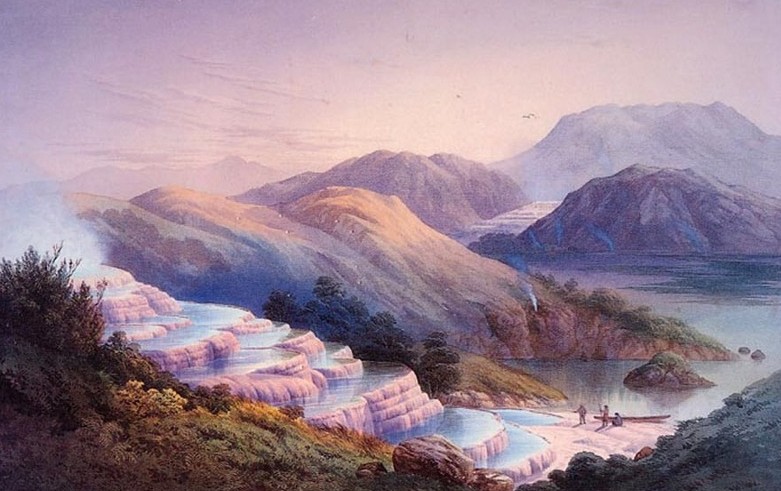| News & Events |
| Location:Home > News & Events > Science and Technology News |
| New Zealand's Lost-and-Found Pink Terraces |
The Pink Terraces that fringed Lake Rotomahana were once New Zealand's proudest tourist attraction. Locals called the immense silica deposits the Eighth Wonder of the World. Then, in 1886, when nearby volcanic activity altered the landscape and raised lake levels substantially, they apparently vanished without a trace. Now, a field expedition has discovered submerged remnants of the natural wonder. The Pink Terraces, along with the White Terraces that fringed the opposite side of the same lake, formed as water from hot, mineral-rich springs cascaded down hillsides through a series of pools. Such deposits are typically white, but scientists suspect that the Pink Terraces gained their color either from trace elements such as iron and manganese dissolved in the boiling spring waters or from a type of heat-loving bacteria that thrived in the warm pools. In June of 1886, while volcanic activity rocked nearby Mount Tarawera, molten rock oozed upward beneath Lake Rotomahana, triggering steam explosions that blasted numerous holes in the lake bottom. The resulting rock-and-sediment-filled debris blocked the stream flowing from the lake, raising water levels about 100 meters and dramatically expanding the lake's size, says Cornel de Ronde, a geologist with GNS Science, a government-owned research institute based in Lower Hutt, New Zealand. Now, de Ronde and his colleagues, including researchers from Woods Hole Oceanographic Institution (WHOI) in Massachusetts, have probed the lake with an autonomous underwater vehicle (AUV) and found parts of the Pink Terraces. During the 2-week-long field study, the 2-meter-long AUV—essentially a sensor-filled, camera-equipped, programmable torpedo—scanned the lakebed with sonar. It detected long, crescent-shaped features at a depth of about 60 meters in an area where the terraces were known to be located. "I never really thought in my wildest dreams we'd find these," says de Ronde. "We've categorically found the bottom tiers of the Pink Terraces. ... For New Zealanders, this is the equivalent of finding the Titanic." Simon Nathan, a historian and science editor of the Web site Te Ara, the Encyclopedia of New Zealand, agrees. "There was nothing quite like these terraces anywhere else. … It was widely believed that they were destroyed, but for the first time we can say, 'Yes, some of the Pink Terraces still survive.' " The researchers found no signs of the upper levels of the Pink Terraces or any of the White Terraces, says de Ronde. Those features either were destroyed in the 1886 eruptions or are now covered with layers of sediment too thick for the sonar to penetrate, says de Ronde. Besides capturing images of the sediment-covered terraces, the AUV revealed that water temperatures near the features were about 1°C warmer than those measured elsewhere in the lake depths, says Daniel Fornari, a marine geophysicist at WHOI. That, along with chemical analyses of the water there, is a sure sign that the long-submerged springs are still spewing hot, mineral-rich water, he notes. Given the right circumstances, small versions of the mineral chimneys found growing at many deep-sea hydrothermal vents could form in the lake. There are few examples of large, land-based hydrothermal features that have been disrupted by an eruption, says de Ronde. Data collected during the recent expedition should help researchers better understand how such systems, like the hot springs and geysers in Yellowstone National Park, respond to geological disturbances, he adds. |
| Appendix Download |
|
|
